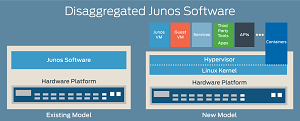News
Juniper Disaggregates Junos Software from Hardware, Boosts NFV Efforts
Following the software-defined networking (SDN) tenet of disaggregating hardware from software, Juniper Networks Inc. has done the same with its own offerings. The company also expanded its network functions virtualization (NFV) portfolio in yet another nod to the disruptive new-age networking movement.
At its customer summit, the hardware-centric Juniper this week announced its Junos network OS software would be disaggregated from its hardware to give customers more options in their datacenter deployments.
"Put simply, our hardware can be deployed with third-party networking applications and services, and our Junos software can also be used on third-party hardware," exec Jonathan Davidson said in a blog post Tuesday.
The company said enterprise developers will be able to program directly to its systems via the Open Compute Project (OCP) defined software model. That project shares designs of datacenter products among companies.
Juniper said it saw a need to separate hardware from software to give IT organizations more flexibility on their platform of choice, while leveraging long-term software investments and replacing hardware as needed.
 [Click on image for larger view.] The Old Model vs. the New Model (source: Juniper Networks).
[Click on image for larger view.] The Old Model vs. the New Model (source: Juniper Networks).
"To address this need, we developed a disaggregated version of the Junos software infrastructure," the company said in an article on its Web site. "It's modular, based on Linux, and built from the ground up for automation and programmability. The disaggregated software allows users to manage the datacenter switch just like a server -- you can run third-party applications, tool, and virtualized services in a virtual machine (VM), or as containers directly on the switch."
Along with the disaggregation, Juniper introduced a new line of QFX5200 access switches, providing the first platform to run the separate Junos software and support the emerging 25 and 50 Gigabit Ethernet (GbE) standard.
The company also expanded its NFV portfolio with the introduction of Cloud CPE.
"Juniper's new Cloud CPE, a fully automated, end-to-end network functions virtualization solution, builds on the proven ability of Juniper Networks Contrail Networking to scale across all models -- whether on-premises or in the cloud -- to make service delivery from an end user's perspective as easy as downloading a new app," the company said. Contrail is the Juniper's SDN overlay platform.
Cloud CPE comprises Contrail Service Orchestration, a management and orchestration platform for working with virtualized network services, and the NFX250, described as "the first in a series of network services platforms that can operate as secure, on-premises devices running multiple virtual network functions, from Juniper and third parties, simultaneously."
While describing Juniper as a software company, Davidson said it wasn't yet a software business, which the firm aimed to change. "All of these changes are enabled by a major shift over the past few years in how Juniper Networks builds software," Davidson said. "We have been moving towards continuous integration/continuous delivery and ensuring that we have the best software practices for how software is written and tested. We have more to do, but the structural changes to Juniper software are paying off. They have produced the innovations we are announcing today."
About the Author
David Ramel is an editor and writer at Converge 360.